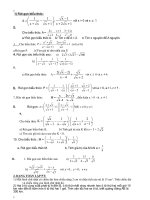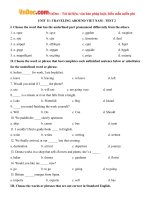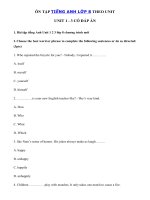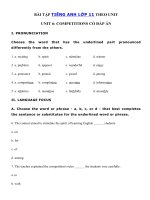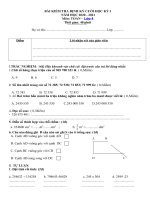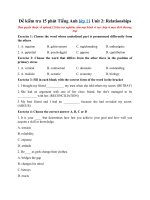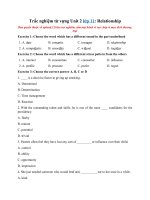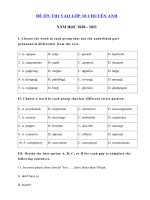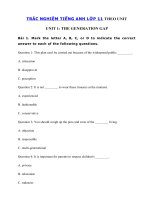Tải Bài tập unit 2 lớp 11 Relationships - Bài tập tiếng Anh lớp 11 Unit 2 Relationships có đáp án
Bạn đang xem bản rút gọn của tài liệu. Xem và tải ngay bản đầy đủ của tài liệu tại đây (86.23 KB, 8 trang )
<span class='text_page_counter'>(1)</span><div class='page_container' data-page=1>
<b>TRẮC NGHIỆM TIẾNG ANH LỚP 11 </b>
<b> THEO UNIT</b>
<b>UNIT 1: THE GENERATION GAP</b>
<b>Bài 1. Choose the best answers for the following questions.</b>
The generation gap, which refers to a broad difference between one generation and
another, especially between young people and their parents, usually leads to numerous
conflicts. Such family conflicts can seriously threaten the relationship between parents
and children at times.
It goes without saying that, however old their children are, parents still regard them as
<b>small kids and keep in mind that their offspring are too young to protect themselves</b>
cautiously or have wise choices. Therefore, they tend to make a great attempt to help
their children to discover the outside world. Nevertheless, they forget that as children
grow up, they want to be more independent and develop their own identity by creating
their own opinions, thoughts, styles and values about life.
One common issue that drives conflicts is the clothes of teenagers. While teens are keen
on wearing fashionable clothes which try to catch up with the youth trends, parents who
value traditional clothes believe that those kinds of attire violate the rules and the norms
of the society. It becomes worse when the expensive brand name clothes teens choose
seem to be beyond the financial capacity of parents.
Another reason contributing to conflicts is the interest in choosing a career path or
education between parents and teenagers. Young people are told that they have the world
at their feet and that dazzling future opportunities are just waiting for them to seize.
However, their parents try to impose their choices of university or career on them
regardless of their children's preference.
</div>
<span class='text_page_counter'>(2)</span><div class='page_container' data-page=2>
<b>Question 1: Why do most parents still treat their teenage children like small kids?</b>
A. Because children usually make mistakes
B. Because they think that children are too young to live independently.
C. Because they think that children can't protect themselves well.
<b>Question 2: The word “offspring” in the second paragraph refers to________.</b>
A. parents
B. children
C. mind
<b>Question 3: What do parents usually do to help their children as they are young?</b>
A. They prepare everything for their children.
B. They take care of their children carefully.
C. They encourage their children to explore the outside world.
<b>Question 4: Which kinds of clothes do teenagers want to wear?</b>
A. latest fashionable clothes
B. casual clothes
C. shiny trousers and tight tops
<b>Question 5: According to the passage, what are parents' viewpoints about the</b>
teenagers' clothes?
A. Teenagers' clothes get the latest teen fashion trends.
</div>
<span class='text_page_counter'>(3)</span><div class='page_container' data-page=3>
C. Teenagers' clothes are contrary to the accepted standards and values of the society
<b>Question 6: Why do teenagers want to choose their university or career?</b>
A. They want to explore the world on their own.
B. They want to decide their future by themselves.
C. Both A and B are correct.
<b>Question 7: The word “seize” in the fourth paragraph is closest in meaning</b>
to________.
A. catch
B. choose
C. find
<b>Bài 2. Read the following passage and mark the letter A, B, C,</b>
<b>or D to indicate the correct answer to each of the questions.</b>
In American, although most men still do less housework than their wives, that gap has
been halved since the 1960s. Today, 41 per cent of couples say they share childcare
equally, compared with 25 percent in 1985. Men's greater involvement at home is good
for their relationships with their spouses, and also good for their children. Hands-on
fathers make better parents than men who let their wives do all the nurturing and
childcare. They raise sons who are more expressive and daughters who are more likely to
do well in school - especially in math and science.
</div>
<span class='text_page_counter'>(4)</span><div class='page_container' data-page=4>
than half say they expect to do so in the next 10 years. Older people are less likely to be
impoverished or incapacitated by illness than in the past, and have more opportunity to
develop a relationship with their grandchildren.
Even some of the choices that worry people the most are turning out to be
<b>manageable. Divorce rates are likely to remain high, and in many cases marital</b>
breakdown causes serious problems for both adults and kids. Yet when parents minimize
<b>conflict, family bonds can be maintained. And many families are doing this. More</b>
non-custodial parents are staying in touch with their children. Child-support receipts are
rising. A lower proportion of children from divorced families are exhibiting problems
than in earlier decades. And stepfamilies are learning to maximize children's access to
supportive adults rather than cutting them off from one side of the family.
<b>Question 8: Which of the following can be the most suitable heading for paragraph</b>
1?
A. Men's involvement at home
B. Benefits of men's involvement at home
C. Drawbacks of men's involvement at home
D. Children studying math and science
<b>Question 9: Nowadays, ____ of men help take care of children.</b>
A. 50%
B. 41%
C. 25%
D. 20%
<b>Question 10: According to the writer, old people in the USA ____.</b>
</div>
<span class='text_page_counter'>(5)</span><div class='page_container' data-page=5>
B. receive less care from their children than they used to
C. have better relationships with their children and grandchildren
D. may live in worst living conditions
<b>Question 11: Which of the following is NOT true about divorce rates in the USA?</b>
A. They will still be high.
B. They can cause problems for both parents and children.
C. More problems are caused by children from divorced families.
D. Children are encouraged to meet their separate parents.
<b>Question 12: The word "equivalent” in paragraph 2 is closest in meaning to</b>
____.
A. comparable
B. opposed
C. dissimilar
D . constrasting
<b>Question 13: The word "manageable” in paragraph 3 is closest in meaning to</b>
____.
A. difficult
B. challenging
C. demanding
D. easy
</div>
<span class='text_page_counter'>(6)</span><div class='page_container' data-page=6>
A. getting divorced
B. minimizing conflict
C. causing problems to kids
D. maintaining bonds
<b>Question 15: According to the writer, the future of American family life can be</b>
____.
A. positive
B. negative
C. unchanged
D. unpredictable
<b>Bài 3. Read the following passage and mark the letter A, B, C,</b>
<b>or D to indicate the correct word or phrase that best fits each</b>
<b>of the numbered blanks.</b>
Fathers in today families are spending more time with their children than at any point in
the past 100 years. (16) ________ the number of hours the average woman spends at
home with her children has declined since the early 1900s, as more and more women
enter the workforce, there has been a decrease in the number of children per family and
an increase in (17) _______ attention to each child. As a result, mothers today in the
United States, (18) _________ those who work part- 0r full-time, spend almost twice as
much time with each child as mothers did in the 1920s. People (19) _______raised
children in the 1940s and 1950s typically report that their own adult children and
grandchildren communicate far better with their kids and spend more time (20)
_________ with homework than they did.
</div>
<span class='text_page_counter'>(7)</span><div class='page_container' data-page=7>
more likely to lose an older teen (22) _______ death. If we look back over the last
millennium, we can see that families have always been diverse. In each period, families
have solved one set of problems only to face new (23) ______ . What works for a family
in One economic and cultural setting doesn’t work for a family in another. What’s
helpful (24) _________ one stage of a family’s life may be (25) _________at the next
stage. If there is one lesson to be (26) _______from the last millennium of family
history, it’s that families always have to (27) _______ with a changing world.
<b>(Source: Adapted/rom U.S. Society and Values)</b>
16. A. Although B. However C. Unless D. Besides
17. A. isolated B. individual C. unique D. single
18. A. adding B. counting C. taking D. including
19. A. whom B. which C. who D. when
20. A. helping B. to help C. help D. on help
21.A. never B. already C. ever D. just
22. A. in B. for C. to D. with
23. A. challanger B. challenges C. challenging D. challenged
24. A. at B. for C. in D. by
25. A. destruction B. destroying C. destroyed D. destructive
26. A. drawing B. drawn C. draw D. drew
27. A. put up B. live up C. go up D. catch up
<b>Đáp án: </b>
1. C 2. B 3. C 4. A 5. C 6. C 7. A 8. B
9. B 10. C 11. C 12. A 13. D 14. B 15. A 16. A
17. B 18. D 19. C 20. A 21. C 22. C 23. B 24. A
25. D 26. B 27. D
</div>
<span class='text_page_counter'>(8)</span><div class='page_container' data-page=8>
Bài tập Tiếng Anh lớp 11 theo từng Unit:
Bài tập Tiếng Anh lớp 11 nâng cao:
</div>
<!--links-->
